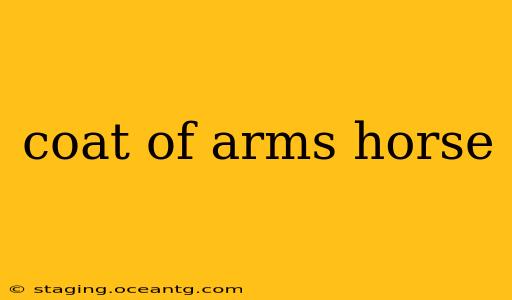The horse, a symbol of power, freedom, and nobility, frequently graces coats of arms across the globe. Its presence isn't merely decorative; it conveys a wealth of meaning, reflecting the values and lineage of the bearer. This comprehensive guide delves into the fascinating world of the horse in heraldry, exploring its various depictions, symbolic interpretations, and historical significance.
What Does a Horse Symbolize in a Coat of Arms?
The symbolism of a horse in a coat of arms is multifaceted and deeply rooted in history. Generally, it represents:
- Nobility and Chivalry: Horses were historically associated with the aristocracy and knights. Their depiction signifies high social standing, courage, and martial prowess.
- Speed and Agility: The horse's swiftness symbolizes swift action, quick thinking, and the ability to overcome obstacles.
- Power and Strength: The sheer strength of a horse translates into a heraldic representation of might, endurance, and resilience.
- Loyalty and Fidelity: Horses, especially those ridden by knights, represent loyalty to one's lord, cause, or ideals.
- Freedom and Independence: The untamed spirit of a wild horse can signify freedom, independence of thought, and a rebellious nature.
The specific meaning, however, can vary based on the horse's posture, color, and accompanying elements within the coat of arms. A rearing horse, for instance, conveys a more aggressive and defiant message than a peacefully grazing one.
What are the Different Types of Horses Depicted in Coats of Arms?
The diversity of equine depictions in heraldry is remarkable. Some common variations include:
- Rampant Horse: A horse rearing on its hind legs, often a symbol of fierceness and defiance.
- Passant Horse: A horse walking calmly, representing steadiness and composure.
- Current Horse: A horse running or galloping, suggesting speed and action.
- Coupled Horses: Two horses shown together, potentially signifying teamwork, partnership, or duality.
The color of the horse is equally significant. A black horse might represent mourning or mystery, while a white horse could symbolize purity or innocence. The details of the horse's harness and tack can also provide further insight into the intended message.
How is the Horse Depicted Differently in Various Heraldic Traditions?
Heraldic traditions vary across countries and cultures, leading to subtle differences in how horses are depicted. While the core symbolism remains relatively consistent, the artistic style and specific details may vary significantly. For example, the style of a horse in a British coat of arms will differ from one found in a French or German coat of arms. Studying these stylistic variations adds another layer of complexity and interest to the study of heraldic horses.
What are the Historical Examples of Coats of Arms Featuring Horses?
Numerous historical figures and families have incorporated horses into their coats of arms. Researching specific examples provides valuable context and understanding of the symbolism in question. For instance, examining the coats of arms of prominent knights or noble families can illuminate the evolution and interpretation of this powerful symbol across different historical periods. While specifics are beyond the scope of this article, numerous online resources and heraldic texts can offer further examples.
What are Some Common Mistakes People Make When Interpreting Coats of Arms with Horses?
A common mistake is assuming a single, universal meaning for a horse in a coat of arms. The significance is always context-dependent, influenced by the horse's posture, color, and the overall design of the coat of arms. Another pitfall is neglecting the accompanying elements within the design. The horse's interaction with other symbols profoundly affects its overall interpretation. Careful and comprehensive analysis is crucial for accurate interpretation.
This exploration merely scratches the surface of the rich tapestry of equine symbolism in heraldry. Further research into specific coats of arms, historical contexts, and heraldic traditions will reveal a deeper appreciation for the majestic horse's enduring presence in this fascinating field.
